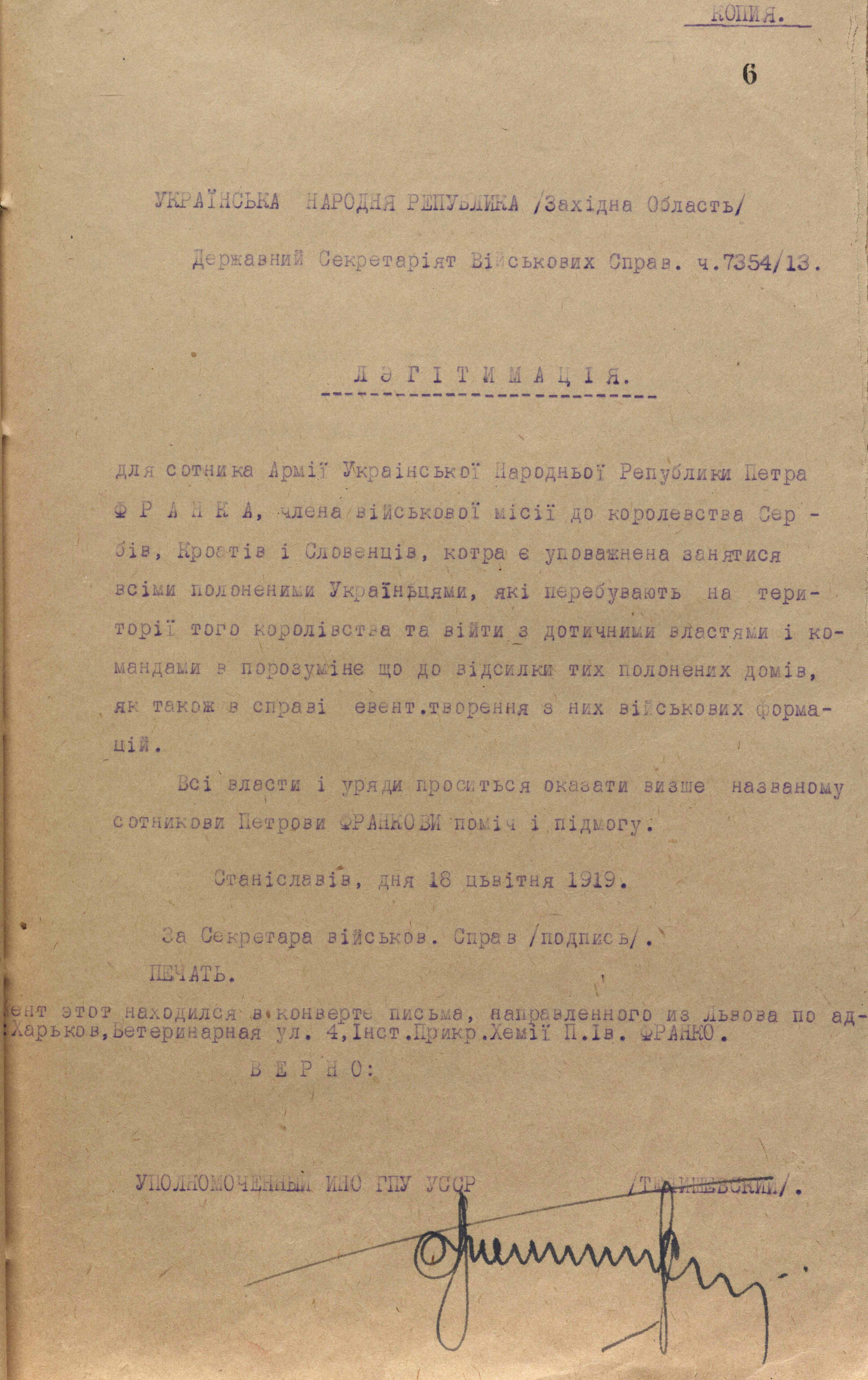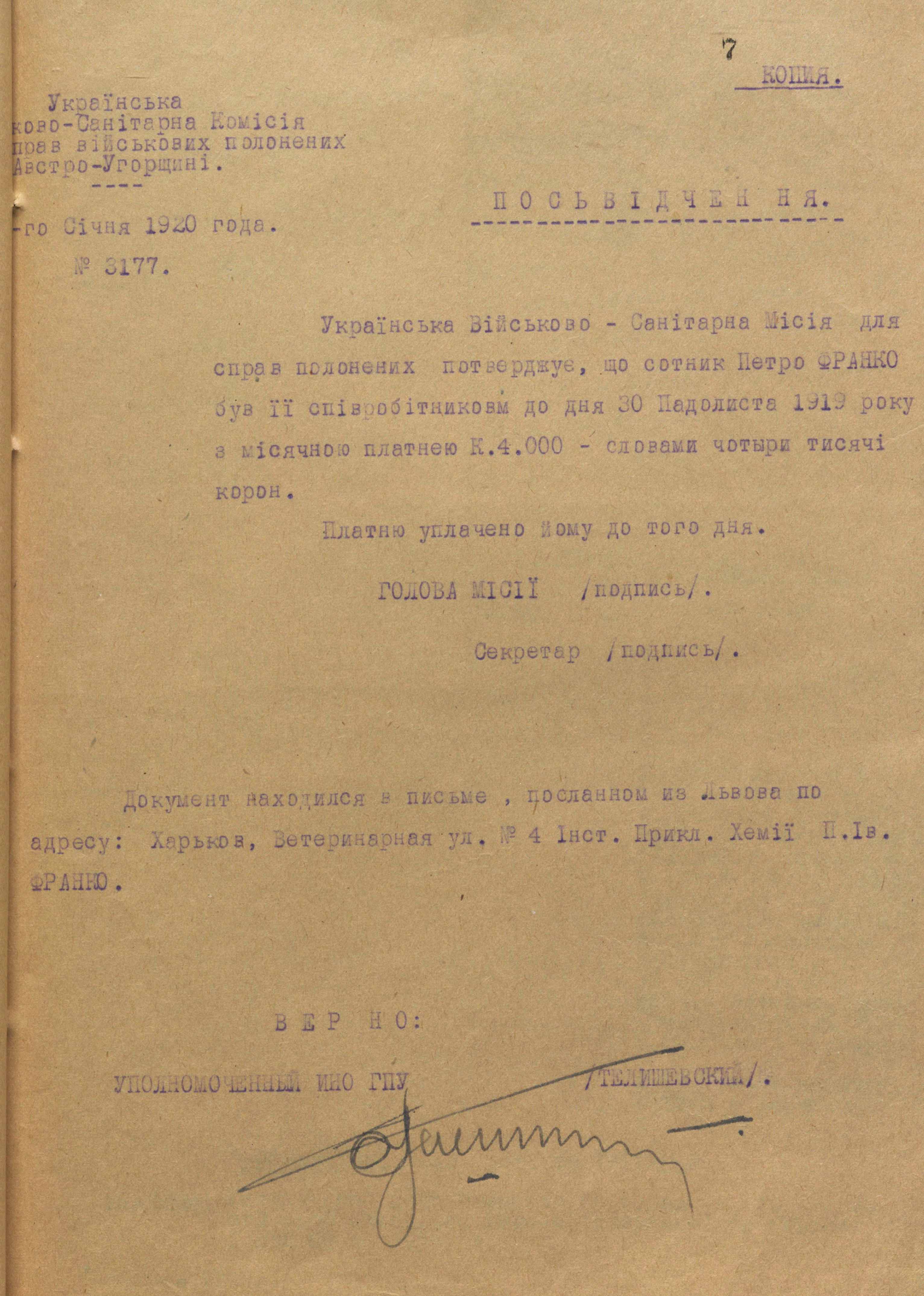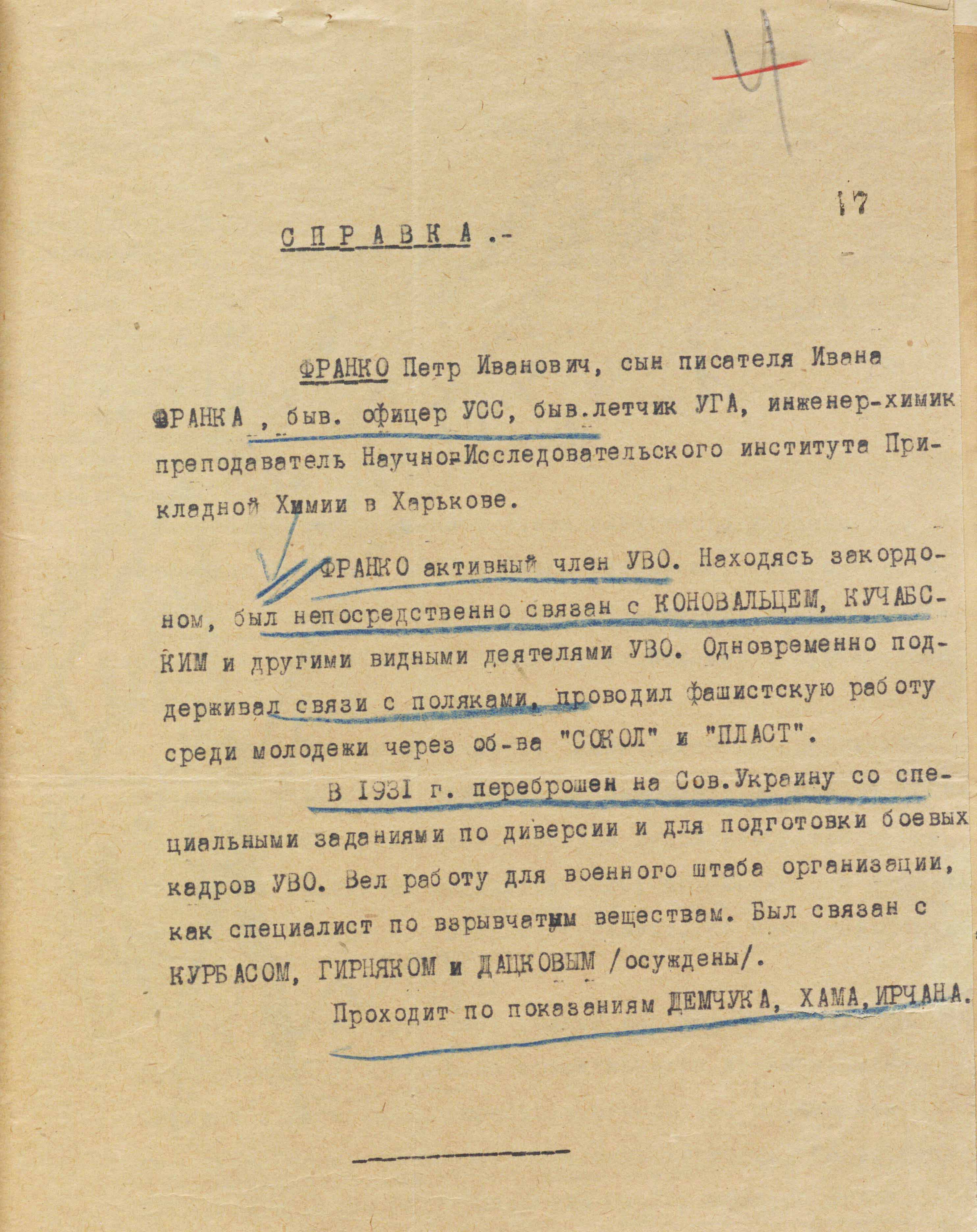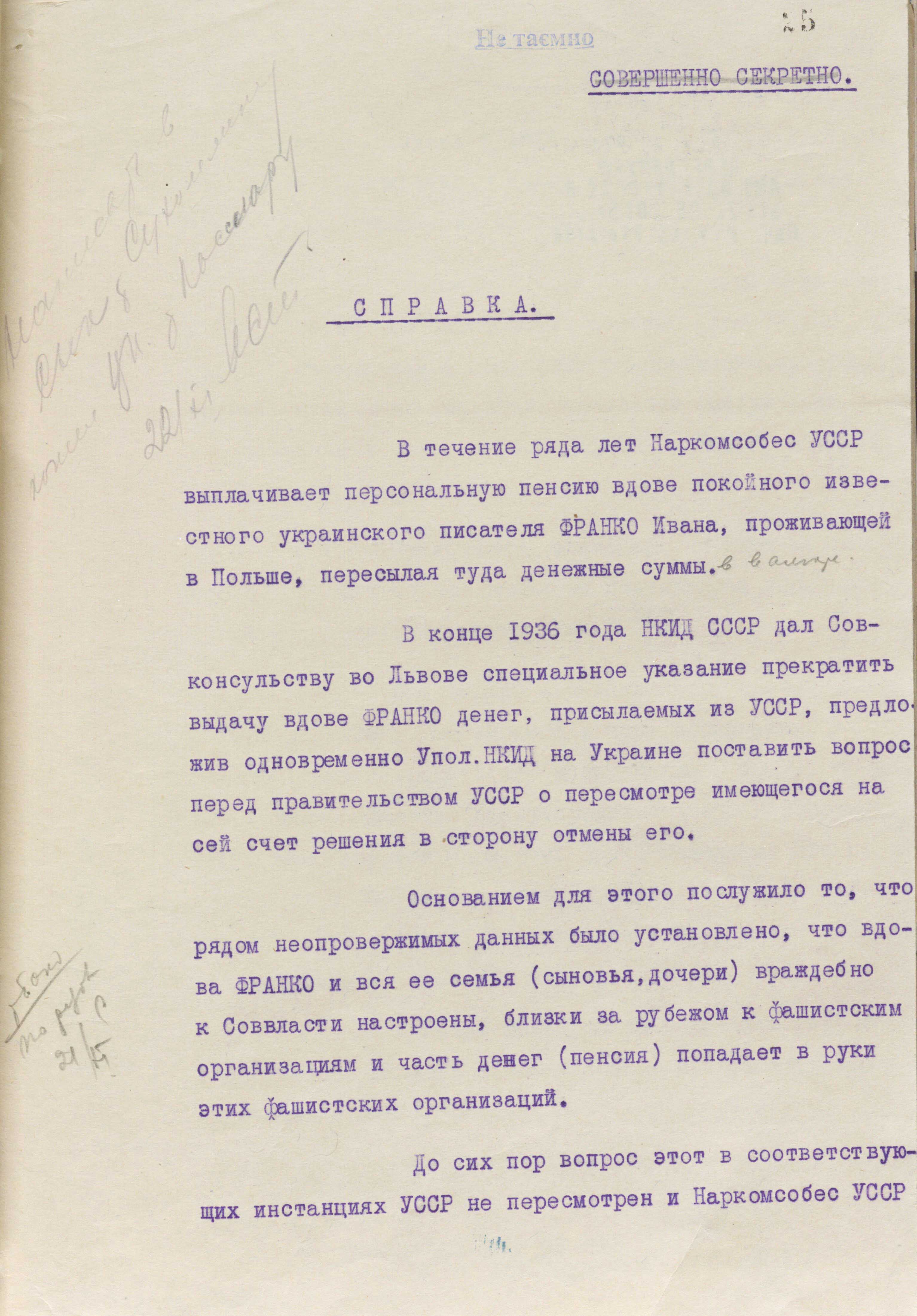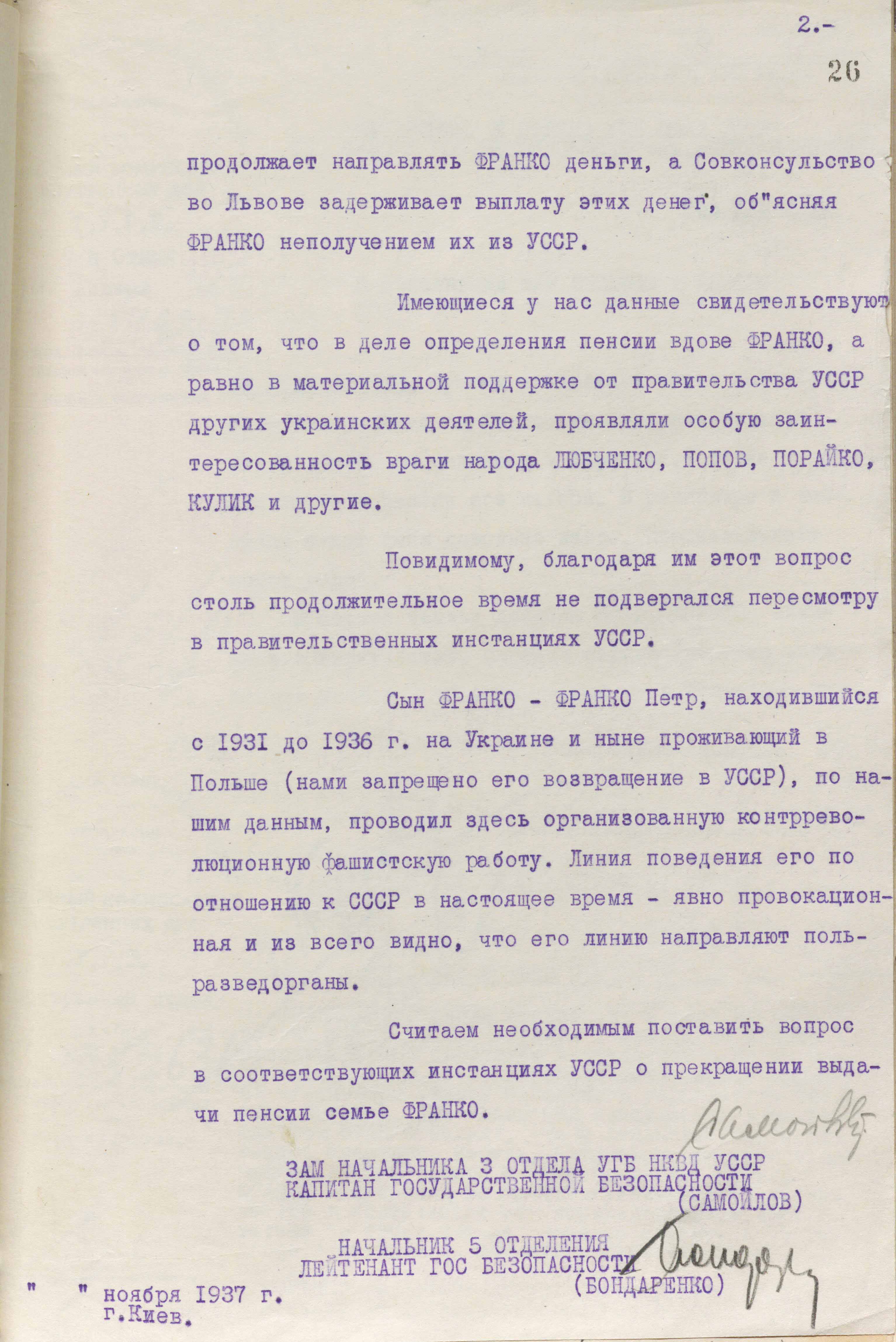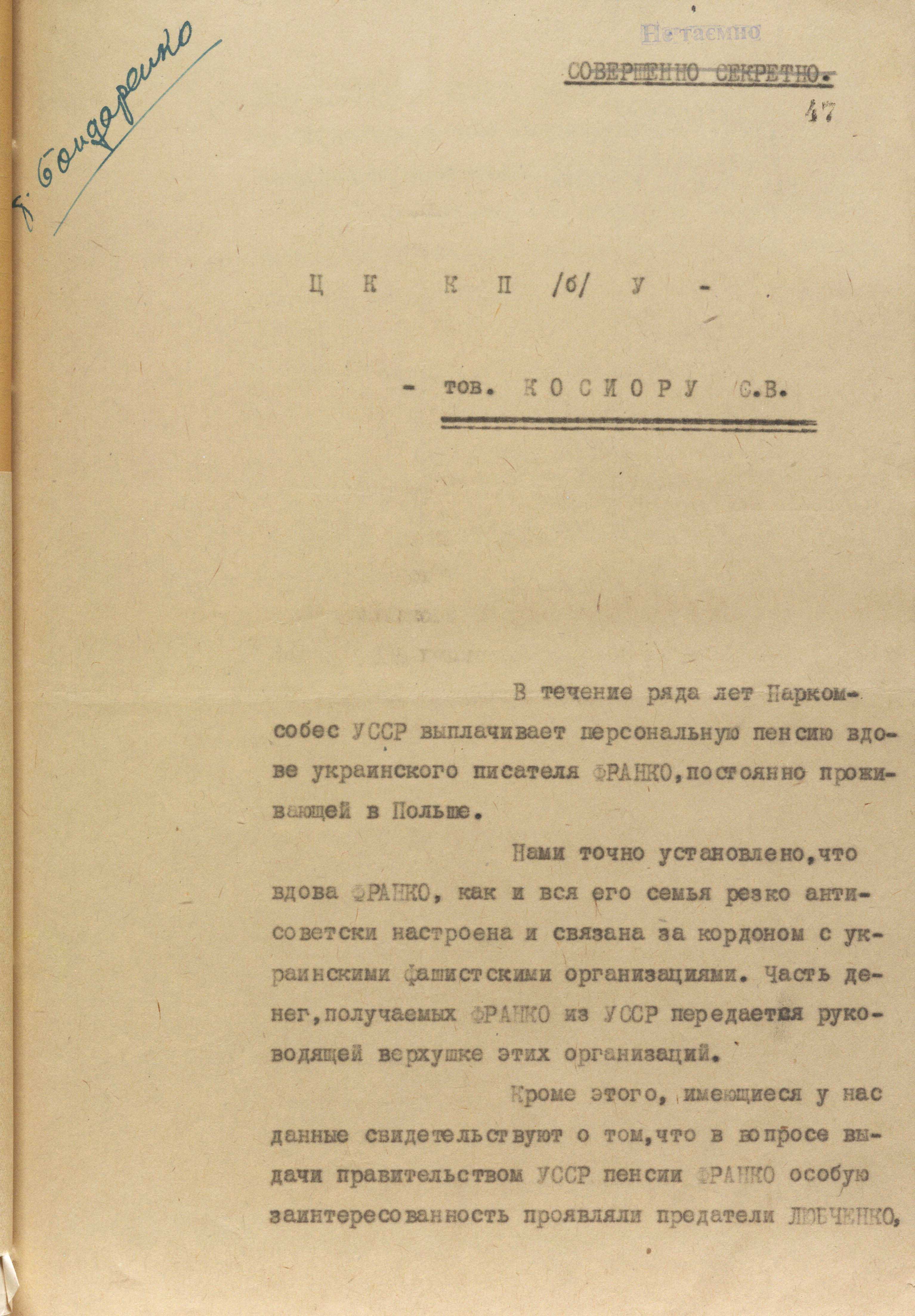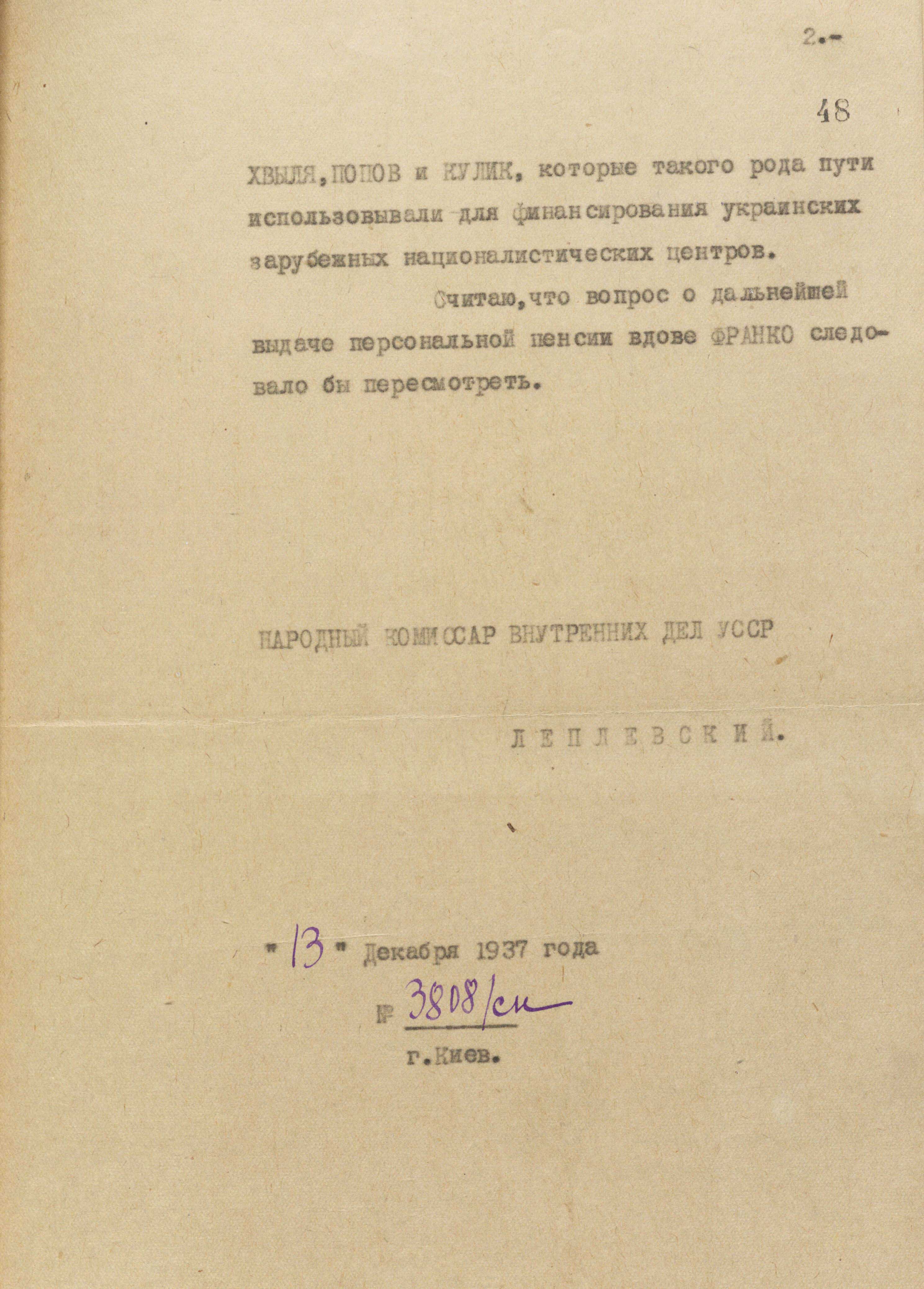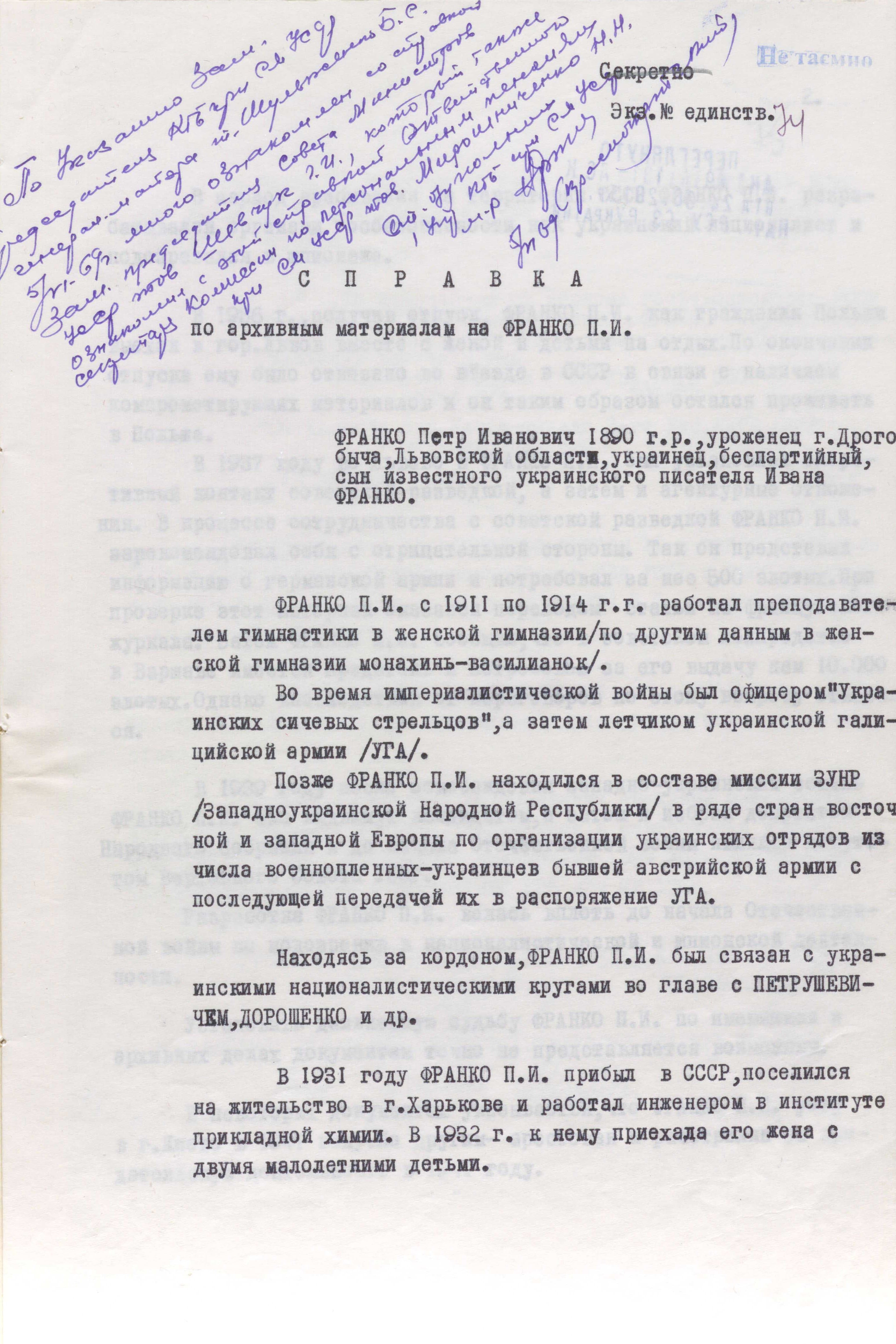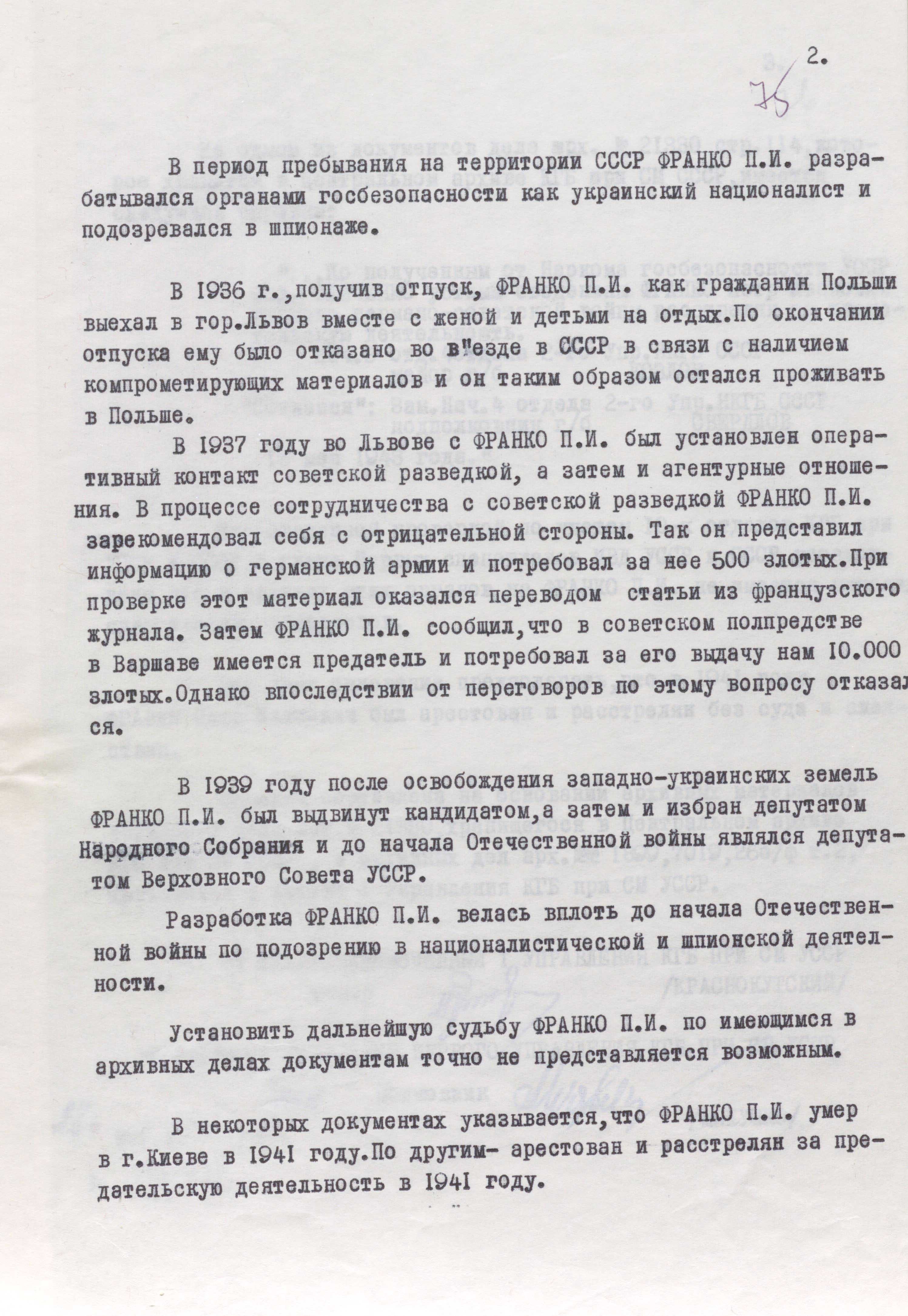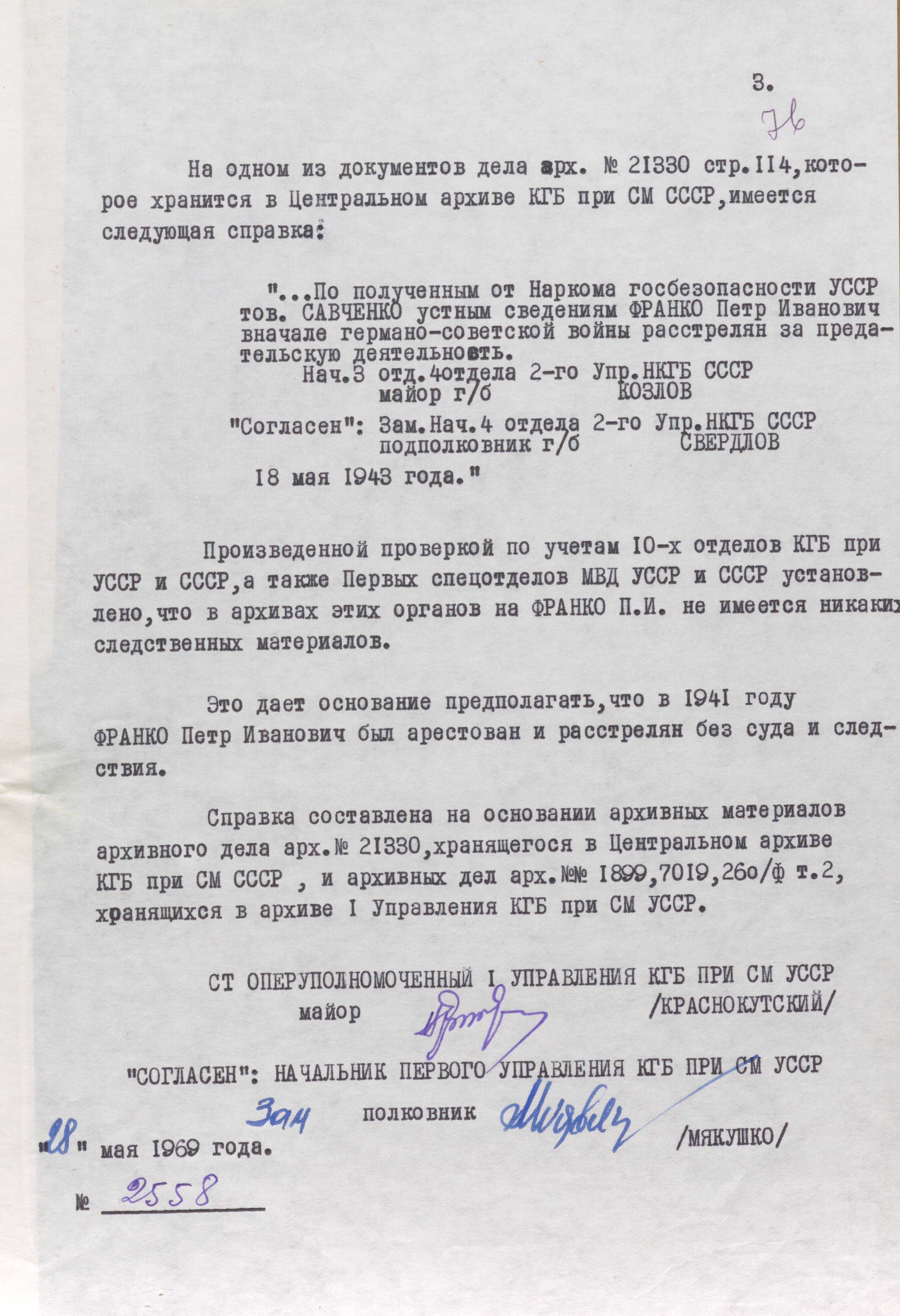Petro Franko. Mysteries of His Life and Death
6/28/2025
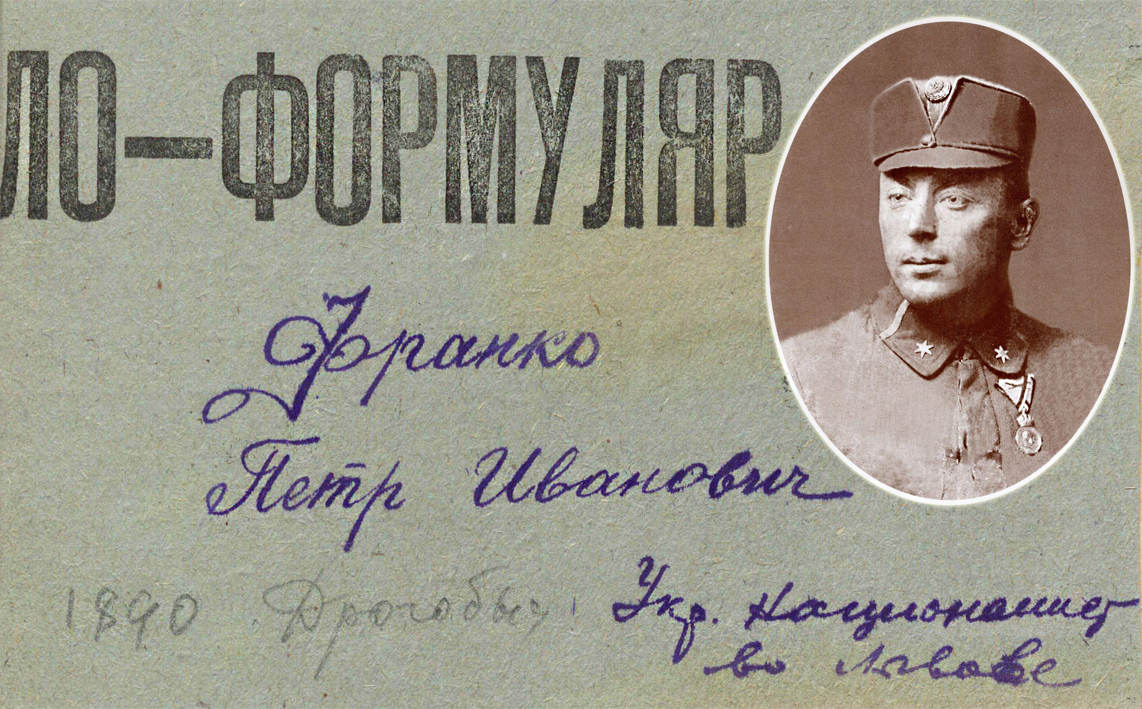
On June 28, 1890 (as he himself wrote in his autobiography), the youngest of Ivan Franko’s three sons, Petro, was born. He went down in the history of the liberation struggle as one of the founders of the Ukrainian scout organization “Plast”, a brave Starshyna (senior officer) of the Legion of Ukrainian Sich Riflemen, and Commander of the Aviation Unit of the Ukrainian Galician Army. For Stalin’s regime, he became a dangerous enemy of the people, who was probably liquidated in the early days of the German-soviet war. The details of the murder have not been fully clarified yet. The case file on P. Franko from the archives of the Foreign Intelligence Service of Ukraine sheds some light on the events related to the commission of that crime by the nkvd.
“The Whereabouts of His Father, Ivan Franko, Have Not Been Established.”
The case file on Petro Ivanovych Franko, as evidenced by the title page, was opened by the foreign department of the nkvd of the Ukrainian ssr on September 21, 1936. At the same time, the first document attached to the case is dated August 25, 1932. It bears the inscription: “In the case of “Writer”. The chekists gave him this operational code name either because of his father’s activity, or because Petro himself wrote historical stories, research papers, and textbooks on the history of “Plast” and physical culture, memoirs about his father, and screenplays based on his works. Therefore, it can be assumed that P. Franko had been under the scrutiny of the then gpu for several years. This document is important for understanding why the chekists were so interested in him. It is therefore worth quoting in full.
“Son of the famous Ukrainian writer Franko, Petro Franko, a former Petliura’s officer, lives in Kharkiv and currently works at the Institute of Applied Chemistry at 4 Veterynarna Street.
It is necessary to identify him, check him against the materials of the USO, INO, and UNTS, and if he is not listed anywhere, assign the OO [special department], SPO [secret political department], and EKU [economic department] (if they serve the Institute) to investigate and clarify his activities, ties, their characteristics, etc. Thoroughly find out his citizenship.
Find out from “Lebed” everything he knows about him...”
(FISU. – F.1. – Case 7019. – P. 3).
It was understood that during that period (1931–1936), P. Franko, at the invitation of the soviet government, traveled with a group of Polish engineers from Lviv, where he was then living, to Kharkiv to work at the Research Institute of Applied Physics, Chemistry, and Dairy Industry. There he engaged in scientific activities that were new to him, became the author of 36 inventions in the field of chemistry, prepared a textbook on inorganic chemistry and an encyclopedic dictionary of chemical terminology. At the same time, the chekists were concerned about his past active participation in the liberation struggle for Ukraine’s independence. Therefore, that trip was viewed as nothing less than espionage aimed at gathering information about the state of affairs in the ussr.
One of the nkvd reports states exactly this:
“Franko is an active member of the UVO [Ukrainian Military Organization]. While abroad, he was directly associated with Konovalets, Kuchabskyi, and other prominent figures of the UVO. At the same time, he maintained ties with the Poles and carried out fascist work among young people through the “Sokil” and “Plast” societies.
In 1931, he was transferred to soviet Ukraine with special tasks related to sabotage and training combat personnel for the UVO. He worked for the Organization’s military headquarters as an expert in explosives. He was associated with Kurbas, Hirniak, and Datskov (all convicted). (FISU. – F.1. – Case 7019. – P. 17).
The involvement of agent “Lebed” (aka Vasyl Khomyak) in the operational cultivation of P. Franko was not accidental. As a former member of the Ukrainian Sich Riflemen, he could have known him from their joint service. With the outbreak of World War I, Petro Franko and his friends from “Plast” joined the Ukrainian Sich Riflemen Legion. For a year, he was a commander of a chota in Roman Susko’s hundred. Soon, with the rank of Lieutenant, he commanded a hundred of the Ukrainian Sich Riflemen Legion. At that time, V. Khomyak also served with R. Sushko. Despite this, there are no intelligence reports from “Lebed” in the case which would relate to those past events and the topic of operational cultivation in general.
Instead, the chekists persistently investigated various milestones in P. Franko’s biography through other means. According to declassified documents, they took control of his correspondence. In the letters sent to him from Lviv to Kharkiv, they found a number of different documents. Those documents were probably sent at his request by close relatives for use in writing his memoirs or for some other purpose. The texts of the papers were reproduced on a typewriter. One of them was issued by the State Secretariat of Military Affairs of the Ukrainian People’s Republic on April 18, 1919, stating that P. Franko was a member of the military mission to the Kingdom of Serbs, Croats, and Slovenes, which was authorized to deal with Ukrainian prisoners of war.
Another document was issued by the Embassy of the Western Ukrainian People’s Republic and dated October 23, 1919. It states that Sotnyk Petro Franko is traveling on official business from Vienna to Yugoslavia and back, and requests assistance in crossing the border and traveling through the countries of stay, and, if necessary, even security. The details of the nature of this “official business” were unknown. Only years later did it become clear that his stay in a number of European countries at that time was connected with “the organization of Ukrainian units among Ukrainian prisoners of war of the former Austrian army, with their subsequent transfer to the disposal of the UGA”.
Documents from the 1930s contain no information about P. Franko’s participation in the formation of military aviation units of the Ukrainian Galician Army, about the fact that he was the Commander of the “Aviation Department”, participated in combat operations himself, and personally supervised the construction of airfields and the training of young people. Such information, if it fell into the hands of the chekists, could have harmed him even more.
Another paper, dated November 5, 1924, stated that at that time he worked at a gymnasium in Lviv as a physical education teacher. Besides, according to open sources, in 1922–1930 he was a Professor at a Ukrainian Gymnasium in Kolomyia.
After P. Franko’s arrival in Kharkiv, his case file was filled with new materials every year. He was simultaneously cultivated by two operational units of the gpu of the Ukrainian ssr: by the economic department — on suspicion of espionage, and by the secret political department — as a Ukrainian nationalist. At the same time, information was being collected on his close relatives—his mother, who lived in Lviv, his brothers and sister, his wife and daughters, who had moved from Lviv to Kharkiv. One of the operational departments of the gpu of the Ukrainian ssr obtained only the following information about his father: “Petro Franko’s Father, Ivan Franko, was a famous Ukrainian writer in the past; his current whereabouts are unknown” (FISU. – F.1. – Case 7019. – P. 10). And this – despite the fact that Ivan Franko died in 1916 and this information was easy to find.
“Refuse Entry to the ussr”
Petro Franko lived and worked in Kharkiv for five years. It is unknown how his fate would have unfolded if he had stayed longer. The year 1937 was approaching, when the repressions of the stalinist regime reached their peak. With the suspicions surrounding him, he could certainly have been arrested and sentenced to exile or even execution. But at that moment things turned out differently.
Open sources show that he repeatedly received offers from the nkvd to accept soviet citizenship. He responded with a categorical refusal. Finally, in 1936, as a citizen of Poland, he was allegedly forced to leave soviet Ukraine within 24 hours, signing a non-disclosure agreement about what he had seen. It was understood that he had witnessed the Holodomor of 1933 and other soviet realities.
Documents from the Foreign Intelligence Service of Ukraine’s archives provide a different explanation for his leaving the ussr. “In 1936, after receiving leave,” the summary report states, “P.I. Franko, as a citizen of Poland, traveled to Lviv with his wife and children for a vacation. After his vacation ended, he was denied entry into the ussr due to the existence of compromising materials, and he thus remained living in Poland” (FISU. – F.1. – Case 7019. – P. 75). Another nkvd document uses the following wording: “We have prohibited his return to the Ukrainian ssr.”
But even after that, the operational cultivation of P. Franko did not stop. In Lviv, which at that time was part of Poland, he continued to be monitored with the help of nkvd foreign agents and employees of the soviet consulate. In November 1936, the foreign department of the nkvd of the ussr sent a document from moscow to Kyiv stating that P. Franko had repeatedly visited the consulate and demanded to return his property. In his appeals, he pointed out that he had left an apartment, furniture, a book collection, household items, and money in a savings bank in Kharkiv. All this may also indicate that he was not evicted and was not required to leave the ussr, otherwise he would have taken some of those things with him and made arrangements for the remaining items and money.
Eventually, as shown by declassified documents, after lengthy bureaucratic procedures, he was advised to contact the institution in Kharkiv where he worked and which had provided him with an apartment. In the end, all his property and belongings were taken into storage by the Polish consulate in Kharkiv.
“Stop Paying Pension to Petro Franko’s Mother”
Franko had one more reason for frequenting the soviet consulate in Lviv. He often came there to receive, on behalf of his mother, a portion of the pension that was assigned to her as the widow of a prominent Ukrainian writer. The amount of that personal pension, established by the government of the Ukrainian ssr, was the equivalent of 1,000 US dollars a year. One of the documents states that P. Franko was once again given 300 Polish zlotys of this amount. So, obviously, the pension was paid in zlotys. But the kremlin leadership did not like this whole story and decided to put an end to the payments. The way this happened is evidenced by a number of circulars, instructions, and certificates kept in the case file.
It all started with chief of the foreign department of the nkvd of the ussr Abram Slutskyi’s letter from moscow to Kyiv, dated August 22, 1936. From the content of this and other documents of that period, it follows that the main operational cultivation of P. Franko was taken over by the central apparatus of the nkvd. The letter reported that Ivan Franko’s daughter Hanna regularly travelled from Czechoslovakia to Lviv to receive a certain amount of money from the personal pension. During her visits, she allegedly participated in all events organized by Ukrainian nationalist organizations and visited Metropolitan Sheptytskyi. Moreover, she allegedly transferred those funds to the leaders of Ukrainian nationalists for anti-soviet activities. According to the chekists, Petro Franko allegedly did the same. Therefore, the task was set: “check the grounds for granting a pension to Franko’s widow”.
Another document states that at the end of 1936, the people’s commissariat for foreign affairs of the ussr gave the soviet consulate in Lviv a special instruction to stop issuing funds from the Ukrainian ssr. At the same time, it was proposed to raise the issue with the government of the Ukrainian ssr to revise the decision and cancel it. At the same time, the chekists complained about the following: “So far, this issue has not been revised by the relevant authorities of the Ukrainian ssr, and the people’s commissariat for social security of the Ukrainian ssr continues to send Franko money, while the soviet consulate in Lviv delays the payment of this money, explaining that it has not received it from the Ukrainian ssr. The information available to us testifies that the enemies of the people Lubchenko, Popov, Porayko, Kulyk and others showed a special interest in determining the pension for Franko’s widow, as well as in material support from the government of the Ukrainian ssr for other Ukrainian figures...” (FISU. – F.1 – Case 7019. – P. 25-26).
Meanwhile, P. Franko continued to visit the soviet consulate, demanding the return of his property from Kharkiv and insisting on the payment of his mother’s pension. moscow reported that he was sending complaints and appeals to various authorities, “behaving impudently in a conversation with the consul”, “notes of threats are slipping through”, “is starting to blackmail us”, and “is going to do something nasty to the consulate in Lviv”.
As evidenced by the operational correspondence between moscow and Kyiv nkvd, the government of soviet Ukraine continued to allocate funds for a personal pension to Ivan Franko’s widow in 1936-1937, while moscow continued to delay the payments through the soviet consulate in Lviv. In December 1937, chief of the nkvd of the Ukrainian ssr Israel Leplevskyi, at moscow’s insistence, sent a letter to head of the central committee of the communist party(b) of Ukraine Stanislav Kosior, in which he once again justified the need to reconsider this issue. There is no information in the case file on how the issue was finally resolved.
Instead, the chekists tried to use the opportunity to engage P. Franko in cooperation. The pension funds continued to arrive at the consulate. At some point, there accumulated more than 4000 Polish zlotys. The nkvd knew that the family needed that money. If nothing else, Ivan Franko’s widow had been suffering from a serious disease for a long time, which required expensive treatment. And then, as stated in declassified documents, a sinister plan was hatched in the bowels of the nkvd. A moscow resident of the nkvd reported the following:
“If F.’s pension will have to be paid in the future due to some political considerations, then please consider my proposed project of using P. Franko in our interests...
On the grounds of his mother’s pension (which he actually receives), he can be attracted to cooperate with us, given that he loves money. We can meet with him at the consulate when the pension is being paid. This will not be suspicious for Poles, as they know about the payment of money... Let us know your opinion and answer about the pension.” (FISU. – F.1. – Case 7019. – P.52).
There is no information in the case file about the details of how further events unfolded. Obviously, all reports were sent exclusively to moscow and settled there. A paper drawn up by the kgb of the Ukrainian ssr in 1969 on the basis of archival file No. 21330 from the Central Archive of the kgb of the ussr sheds some light on those events. It states that in 1937 a scheduled conversation was held with P. Franko at the soviet consulate in Lviv. The document calls it the establishment of operational contact. In the course of further contacts, as noted below, he “proved himself on the negative side”. In other words, he began to play his game in order to receive proper pension payments for his mother, at the same time trying to have something else in addition.
“For example, he provided information about the German army,” the paper says, “and demanded 500 zlotys for it. When checked, this material turned out to be a translation of an article from a French magazine. Then P. I. Franko reported that there was a traitor in the soviet plenipotentiary mission in Warsaw and demanded 10,000 zlotys for his exposure to us. However, he later refused to negotiate on this issue” (FISU. – F.1. – Case 7019. – P.75).
Apparently, this was the end of all contacts, but the operational cultivation continued. This is evidenced by a conclusion in one of the nkvd documents of that period. It states that P. Franko continued to be in contact with the leaders of Ukrainian nationalist organizations, conducted organized counter-revolutionary activities, and that “his line of behavior towards the ussr is now obviously provocative”.
“According to the Oral Testimony of the people’s commissar for state security of the Ukrainian ssr,... Shot Dead.”
“In 1939, after the liberation of the western Ukrainian lands, P. I. Franko was nominated as a candidate and then elected as a Member of the People’s Assembly”, reads the final document in the case file, “and until the beginning of the Patriotic War he was a Member of the Supreme Soviet of the Ukrainian ssr. The cultivation of P.I. Franko was carried out until the beginning of the Patriotic War on suspicion of nationalist and espionage activities” (FISU. – F.1. – Case 7019. - P. 75).
At that time, he worked as the Dean of the Commodity Science Faculty of the Ukrainian State Institute of soviet Trade in Lviv and became the first Director of the Ivan Franko Literary and Memorial Museum. Such ostentatious glorification of the son of the Great Stonemason and flirting with him were just elements of soviet propaganda on the national issue. For the chekists, he continued to be an object of operational cultivation.
The outbreak of the German-soviet war put everything in its place. According to the testimony of close relatives, from June 22, 1941, P. Franko was closely monitored by the nkvd. On June 26, he was placed under house arrest. And on June 28, his birthday, he was ordered to pack the most necessary things and was taken under escort to the train station and put on a train to Kyiv. He was never seen alive again.
There are several versions of P. Franko’s disappearance in open sources. According to one of the most common, the train came under fire at Proshova station near Ternopil. Everyone was ordered to get off and hide on the side of the railway. When Petro Franko and Professor Kyrylo Studynskyi, a writer and literary critic who was also arrested in Lviv in those days, lay down behind an embankment, the convoy pierced them with a machine gun burst, simulating their murder while trying to escape. There were other versions.
The researchers managed to find a cipher telegram from the nkgb of the ussr, dated July 6, 1941, which was sent from Kyiv by Pavlo Meshyk, people’s commissar for state security of the Ukrainian ssr, to moscow, to Vsevolod Merkulov, people’s commissar for state security of the ussr. It read as follows: “By order of Comrade Khrushchev, we have arrested: Studynskyi, Franko, Kyiv artist Donets, “nationalists”. Since it is difficult to get them out of Kyiv, we consider it expedient to execute them by shooting. The central committee of the communist party of Ukraine is of the same opinion. I ask for immediate instructions”. The telegram contains a resolution “for”. It was signed by L. Beria, V. Molotov, and, most likely, G. Malenkov. There is no information on how exactly the instruction was carried out.
In the already mentioned document, dated May 28, 1969, from the case file No. 7019 on P. Franko from the archives of the Foreign Intelligence Service of Ukraine, there is information that at that time attempts were made to find out what really happened in 1941. The reason for the new search was a petition from the Lviv Regional Executive Committee to the Commission for the Establishment of Personal Pensions under the Council of Ministers of the Ukrainian ssr to grant such a pension to Olha Franko, the wife of Petro Franko. I. Hrushetskyi, the then chairman of the party commission at the central committee of the communist party of Ukraine and former secretary of the Lviv regional committee of the party, who received the petition, recalled that something happened to Petro Franko at the beginning of the war, “he seemed to have disappeared”. So he suggested asking the kgb.
In response to this request, the kgb of the Ukrainian ssr lifted all available documents from the archives. Additionally, a request was made to the Central Archive of the kgb of the ussr. The correspondence itself is not in the case file. After studying all the materials, the generalized paper pointed out the following:
“It is definitely not possible to find out P. I. Franko’s further fate from the documents available in the archival files.
Some documents state that P.I. Franko died in Kyiv in 1941. According to others, he was arrested and shot dead for treasonous activities in 1941.
One of the documents in the archive case No. 21330, p. 114, which is kept in the Central Archive of the kgb of the ussr, contains the following document:
“...According to the oral information received from the people’s commissar for state security of the Ukrainian ssr comrade Savchenko, Franko Petro Ivanovych was shot dead for treasonous activities at the beginning of the German-soviet war.
Chief of the 3 dept. 4th department of the 2nd directorate of the nkgb of the ussr, major of the kgb Kozlov.
“I agree”: deputy chief of the 4th department of the 2nd directorate of the nkgb of the ussr, lieutenant colonel Sverdlov
May 18, 1943” (FISU. – F.1. – Case 7019. – P.75-76).
Further, the document states that an additional check was made on the records of 10 kgb departments under the council of ministers of the Ukrainian ssr and the ussr, as well as the first special departments of the ministries of internal affairs of the Ukrainian and the ussr. In all those archives, no investigative case files on P. Franko were found. Therefore, it was concluded “that in 1941, Petro Ivanovych Franko was arrested and shot dead without trial”. This is an official, documented conclusion of the kgb of the Ukrainian ssr.
So, along with other information and research by historians, newly declassified documents from the archival funds of the Foreign Intelligence Service of Ukraine now allow us to rethink and reinterpret those past events of Ukrainian history and to reassess moscow’s sinister role in the fate of prominent Ukrainian intellectuals.
